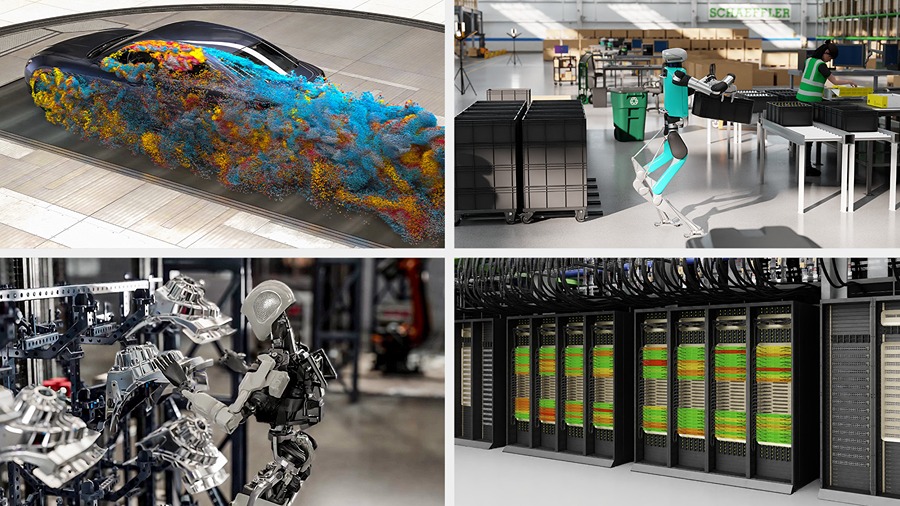
SAN JOSE, CA (GTC), Mar 24, 2025 – NVIDIA unveiled that industrial software and service providers Ansys, Databricks, Dematic, Omron, SAP, Schneider Electric with ETAP, and Siemens are integrating the NVIDIA Omniverse platform into their solutions to accelerate industrial digitalization with physical AI.
NVIDIA Omniverse Blueprints connected to NVIDIA Cosmos world foundation models are available to enable robot-ready facilities and synthetic data generation for physical AI development.
“Omniverse is an operating system that connects the world’s physical data to the realm of physical AI,” said Rev Lebaredian, vice president of Omniverse and simulation technology at NVIDIA. “With Omniverse, global industrial software, data, and professional services leaders are uniting industrial ecosystems and building new applications that will advance the next generation of AI for industries at unprecedented speed.”
New Blueprints Enable Robot-Ready Facilities and Large-Scale Synthetic Data Generation
Mega, an Omniverse Blueprint for testing multi-robot fleets at scale in industrial digital twins, is available in preview on demo platform. Also available is the NVIDIA AI Blueprint for video search and summarization, powered by the NVIDIA Metropolis platform, for building AI agents that monitor activity across entire facilities.
Manufacturing leaders use the blueprints to optimize their industrial operations with physical AI.
In automotive manufacturing, Schaeffler and Accenture are beginning to use Mega to test and simulate fleets of Agility Robotics’ Digit robots for automating material handling. Hyundai Motor Group uses the blueprint to simulate Boston Dynamics’ Atlas robots on its production lines. Mercedes-Benz uses it to simulate Apptronik’s Apollo humanoid robots to improve vehicle assembly processes.
In electronics manufacturing, Pegatron is collaborating with Mega to create AI-driven NVIDIA Metropolis video analytics tools. The tools focus on enhancing factory efficiency and ensuring worker safety. Foxconn is using the framework to model industrial arms, humanoid robots, and mobile robots for the NVIDIA Blackwell platform.
“Foxconn is constantly exploring ways to transform our operations as we continue our journey toward building the factories of the future,” said Brand Cheng, CEO of Fii, a core subsidiary of Foxconn. “Using NVIDIA Omniverse and Mega, we’re testing and training humanoids to operate in our leading factories as we advance to the next wave of physical AI.”
For warehouses and supply chain solutions, KION Group, Dematic , and Accenture are integrating Mega to advance next-gen AI-powered automation. idealworks is integrating Mega into its fleet management software to simulate, test, and optimize robotic fleets. SAP customers and partners are using Omniverse to develop their virtual environments for warehouse management scenarios.
A new Omniverse Blueprint for AI factory digital twins lets data center engineers design and simulate AI factory layouts, cooling, and electrical to maximize utilization and efficiency. Cadence Reality Digital Twin Platform and Schneider Electric with ETAP are the first to integrate their simulation software into the blueprint. Vertiv and Schneider Electric are providing Omniverse SimReady 3D models of their power and cooling units to accelerate the development of AI factory digital twins.
The NVIDIA Isaac GR00T Blueprint for synthetic manipulation motion generation is available for robotics developers, enabling large-scale synthetic data generation from Omniverse and Cosmos. The blueprint helps humanoid developers reduce data collection time from hours to minutes, fast-tracking robot development.
Omniverse Physical AI Operating System Expands Across Industries
Digitalization is challenging for industries grounded in the physical world. Massive amounts of digital and physical world data from legacy systems create silos. Omniverse is an operating system built on the OpenUSD framework that enables developers to unify physical-world data and applications.
Ansys, Cadence, Hexagon, Omron, Rockwell Automation, and Siemens are integrating Omniverse data interoperability and visualization technologies into their industrial software, simulation, and automation solutions to accelerate product development and optimize manufacturing processes.
For physical AI, Intrinsic is enabling Omniverse workflows and NVIDIA robotics foundation models to transition from digital twins to hardware deployments using Flowstate. Databricks is integrating NVIDIA Omniverse with the Databricks data intelligence platform, which will enable synthetic data generation for physical AI.
General Motors announced it uses Omniverse to enhance its factories and train systems for material handling, transportation, and precision welding. Similarly, Unilever shared that it is adopting Omniverse and digital twins to streamline the process of creating marketing content for its products.
Omniverse in Every Cloud
NVIDIA Omniverse is available as virtual desktop images on EC2 G6e instances with NVIDIA L40S GPUs in AWS Marketplace. The Microsoft Azure Marketplace features preconfigured Omniverse instances and Omniverse Kit App Streaming on NVIDIA A10 GPUs, allowing developers to develop and stream their custom Omniverse applications.
The cloud-based NVIDIA Omniverse developer tools and services will be available later this year on Oracle cloud infrastructure compute bare-metal instances with NVIDIA L40S GPUs and NVIDIA RTX PRO 6000 Blackwell server edition on Google Cloud.
OpenUSD Unifies Robotics Workflows
At GTC, NVIDIA introduced the OpenUSD Asset Structure Pipeline for Robotics with Disney Research and Intrinsic.
Source: NVIDIA
About NVIDIA
![]()
NVIDIA Corp. is an American tech company headquartered in Santa Clara, CA. Renowned for designing and manufacturing graphics processing units (GPUs), NVIDIA’s innovations have significantly impacted various sectors. The company’s products and services cater to industries such as gaming, where its GPUs enhance visual experiences; artificial intelligence (AI), providing high-performance computing solutions; automotive, contributing to autonomous vehicle technologies; and robotics, offering advanced AI perception and simulation tools. Over its more than three decades in business, NVIDIA has experienced substantial growth. In the fiscal quarter ending January 2025, the company reported record revenue of $39.3 billion and a net income of $22.1 billion. NVIDIA’s headquarters, designed to facilitate a flat organizational structure, emphasizes information flow and harmony between leadership and employees.
